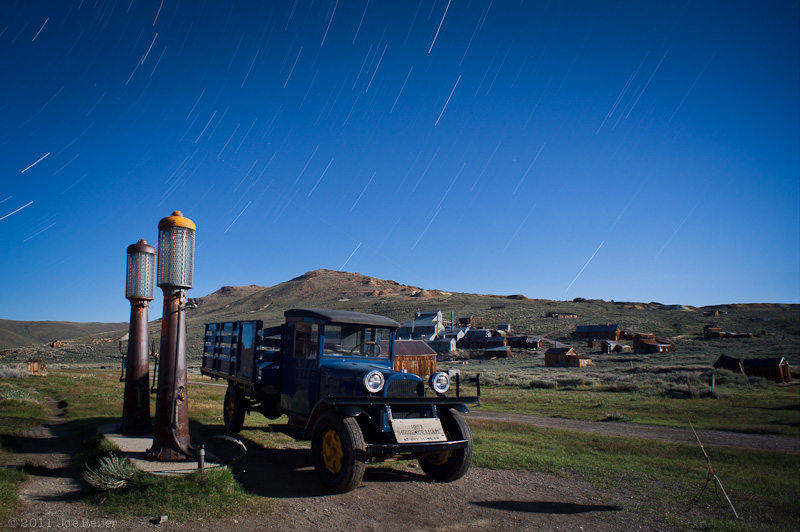Bodie Night Photography: 5D Mark II Wide Angle Lenses and Noise Reduction
The 1927 Dodge truck and gravity gas pumps are a popular subject for photography at Bodie ghost town. This 24 minute night photograph was taken during the 2011 Mono Lake Night Photography Festival.
Wide angle lens for night photography
I shot the entire night at Bodie with a Canon 5D Mark II and an Olympus OM 18mm f/3.5 lens. The Olympus OM system lens can be used on the 5D II with an OM-EOS adapter. The Olympus lens is small, light, and easy to zone focus at night. At an aperture of f/8 or f/11 the lens is quite sharp across the frame, and offers better edge performance than Canon zooms. The Olympus lenses also have a different signature look than other wide angle lens choices. The 18mm is hard to find and can be expensive. The Olympus 21mm f/3.5 is a more readily available, reasonably priced alternative. The 24mm f/2.8 is also quite good. If you prefer a standard wide angle to a super wide lens, the Olympus 28mm f/3.5 is a stellar performer at f/8, and can often be purchased for less than $50. My adapter for the 28mm cost more than the lens!
Image stacking and long exposure noise reduction
Four exposures of 6 minutes at f/8 ISO 200 were combined for the final 24 minute image. There were about 25 night photographers shooting at Bodie -- exposure stacking was very useful for removing people and light painting from the foreground. Using this stacking technique also meant that I did not have to run long exposure noise reduction (LENR) in the camera. This helps productivity and battery life.
5D Mark II Auto setting for long exposure noise reduction (LENR)
Photography instructor Scott Martin let me know about his experiments with the Auto setting for long exposure noise reduction (LENR) on the Canon 5D Mark II. Normally I do not recommend letting the camera decide what to do, but Scott's LENR experiments may prove otherwise. There are 3 settings for LENR:
- Off -- long exposure noise reduction does not run on any shot.
- On -- long exposure noise reduction runs for the same amount of time as your exposure. A 10 minute shot with LENR set to On will run noise reduction for 10 minutes after the exposure ends.
- Auto -- long exposure noise reduction will run if the camera determines it's necessary, for the amount of time necessary to optimize the image.
Here's the really interesting part -- noise reduction won't necessarily run for the same amount of time as the exposure. Auto LENR runs for as long as necessary to reduce noise -- this could be shorter or longer than the original exposure time.
I'd like to thank Scott for sharing his Auto LENR research, and I look forward to my own testing. If you have experience with the Auto LENR setting I'd love to hear how exposure time and temperature correlate to when noise reduction kicks in, and how long Auto LENR tends to run.
